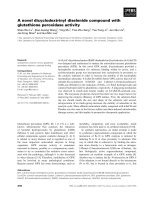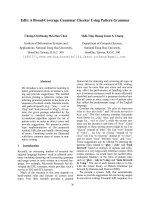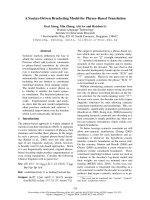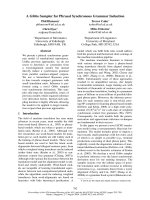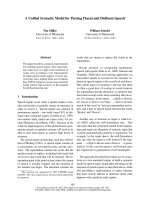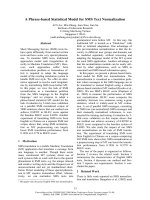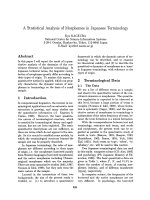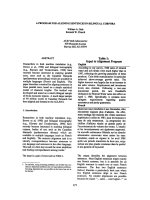Báo cáo khoa học: "A Joint Sequence Translation Model with Integrated Reordering" doc
Bạn đang xem bản rút gọn của tài liệu. Xem và tải ngay bản đầy đủ của tài liệu tại đây (273.77 KB, 10 trang )
Proceedings of the 49th Annual Meeting of the Association for Computational Linguistics, pages 1045–1054,
Portland, Oregon, June 19-24, 2011.
c
2011 Association for Computational Linguistics
A Joint Sequence Translation Model with Integrated Reordering
Nadir Durrani Helmut Schmid Alexander Fraser
Institute for Natural Language Processing
University of Stuttgart
{durrani,schmid,fraser}@ims.uni-stuttgart.de
Abstract
We present a novel machine translation model
which models translation by a linear sequence
of operations. In contrast to the “N-gram”
model, this sequence includes not only trans-
lation but also reordering operations. Key
ideas of our model are (i) a new reordering
approach which better restricts the position to
which a word or phrase can be moved, and
is able to handle short and long distance re-
orderings in a unified way, and (ii) a joint
sequence model for the translation and re-
ordering probabilities which is more flexi-
ble than standard phrase-based MT. We ob-
serve statistically significant improvements in
BLEU over Moses for German-to-English and
Spanish-to-English tasks, and comparable re-
sults for a French-to-English task.
1 Introduction
We present a novel generative model that explains
the translation process as a linear sequence of oper-
ations which generate a source and target sentence
in parallel. Possible operations are (i) generation of
a sequence of source and target words (ii) insertion
of gaps as explicit target positions for reordering op-
erations, and (iii) forward and backward jump oper-
ations which do the actual reordering. The probabil-
ity of a sequence of operations is defined according
to an N-gram model, i.e., the probability of an op-
eration depends on the n − 1 preceding operations.
Since the translation (generation) and reordering op-
erations are coupled in a single generative story,
the reordering decisions may depend on preceding
translation decisions and translation decisions may
depend on preceding reordering decisions. This pro-
vides a natural reordering mechanism which is able
to deal with local and long-distance reorderings in a
consistent way. Our approach can be viewed as an
extension of the N-gram SMT approach (Mari
˜
no et
al., 2006) but our model does reordering as an inte-
gral part of a generative model.
The paper is organized as follows. Section 2 dis-
cusses the relation of our work to phrase-based and
the N-gram SMT. Section 3 describes our genera-
tive story. Section 4 defines the probability model,
which is first presented as a generative model, and
then shifted to a discriminative framework. Section
5 provides details on the search strategy. Section 6
explains the training process. Section 7 describes
the experimental setup and results. Section 8 gives
a few examples illustrating different aspects of our
model and Section 9 concludes the paper.
2 Motivation and Previous Work
2.1 Relation of our work to PBSMT
Phrase-based SMT provides a powerful translation
mechanism which learns local reorderings, transla-
tion of short idioms, and the insertion and deletion of
words sensitive to local context. However, PBSMT
also has some drawbacks. (i) Dependencies across
phrases are not directly represented in the translation
model. (ii) Discontinuous phrases cannot be used.
(iii) The presence of many different equivalent seg-
mentations increases the search space.
Phrase-based SMT models dependencies between
words and their translations inside of a phrase well.
However, dependencies across phrase boundaries
are largely ignored due to the strong phrasal inde-
1045
German English
hat er ein buch gelesen he read a book
hat eine pizza gegessen has eaten a pizza
er he
hat has
ein a
eine a
menge lot of
butterkekse butter cookies
gegessen eaten
buch book
zeitung newspaper
dann then
Table 1: Sample Phrase Table
pendence assumption. A phrase-based system us-
ing the phrase table
1
shown in Table 1, for exam-
ple, correctly translates the German sentence “er
hat eine pizza gegessen” to “he has eaten a pizza”,
but fails while translating “er hat eine menge but-
terkekse gegessen” (see Table 1 for a gloss) which
is translated as “he has a lot of butter cookies eaten”
unless the language model provides strong enough
evidence for a different ordering. The generation of
this sentence in our model starts with generating “er
– he”, “hat – has”. Then a gap is inserted on the Ger-
man side, followed by the generation of “gegessen –
eaten”. At this point, the (partial) German and En-
glish sentences look as follows:
er hat gegessen
he has eaten
We jump back to the gap on the German side
and fill it by generating “eine – a” and “pizza –
pizza”, for the first example and generating “eine –
a”, “menge – lot of”, “butterkekse – butter cookies”
for the second example, thus handling both short
and long distance reordering in a unified manner.
Learning the pattern “hat gegessen – has eaten”
helps us to generalize to the second example with
unseen context. Notice how the reordering deci-
sion is triggered by the translation decision in our
model. The probability of a gap insertion operation
after the generation of the auxiliaries “hat – has” will
be high because reordering is necessary in order to
move the second part of the German verb complex
(“gegessen”) to its correct position at the end of the
clause. This mechanism better restricts reordering
1
The examples given in this section are not taken from the
real data/system, but made-up for the sake of argument.
Figure 1: (a) Known Context (b) Unknown Context
than traditional PBSMT and is able to deal with local
and long-distance reorderings in a consistent way.
Another weakness of the traditional phrase-based
system is that it can only capitalize on continuous
phrases. Given the phrase inventory in Table 1,
phrasal MT is able to generate example in Figure
1(a). The information “hat gelesen – read” is inter-
nal to the phrase pair “hat er ein buch gelesen – he
read a book”, and is therefore handled conveniently.
On the other hand, the phrase table does not have
the entry “hat er eine zeitung gelesen – he read a
newspaper” (Figure 1(b)). Hence, there is no option
but to translate “hat gelesen” separately, translat-
ing “hat” to “has” which is a common translation for
“hat” but wrong in the given context. Context-free
hierarchical models (Chiang, 2007; Melamed, 2004)
have rules like “hat er X gelesen – he read X” to han-
dle such cases. Galley and Manning (2010) recently
solved this problem for phrasal MT by extracting
phrase pairs with source and target-side gaps. Our
model can also use tuples with source-side discon-
tinuities. The above sentence would be generated
by the following sequence of operations: (i) gener-
ate “dann – then” (ii) insert a gap (iii) generate “er
– he” (iv) backward jump to the gap (v) generate
“hat [gelesen] – read” (only “hat” and “read” are
added to the sentences yet) (vi) jump forward to the
right-most source word so far generated (vii) insert
a gap (viii) continue the source cept (“gelesen” is in-
serted now) (ix) backward jump to the gap (x) gen-
erate “ein – a” (xi) generate “buch – book”.
Figure 2: Pattern
From this operation se-
quence, the model learns a
pattern (Figure 2) which al-
lows it to generalize to the
example in Figure 1(b). The open gap represented
by serves a similar purpose as the non-terminal
categories in a hierarchical phrase-based system
such as Hiero. Thus it generalizes to translate “eine
zeitung” in exactly the same way as “ein buch”.
1046
Another problem of phrasal MT is spurious
phrasal segmentation. Given a sentence pair and
a corresponding word alignment, phrasal MT can
learn an arbitrary number of source segmentations.
This is problematic during decoding because differ-
ent compositions of the same minimal phrasal units
are allowed to compete with each other.
2.2 Relation of our work to N-gram SMT
N-gram based SMT is an alternative to hierarchi-
cal and non-hierarchical phrase-based systems. The
main difference between phrase-based and N-gram
SMT is the extraction procedure of translation units
and the statistical modeling of translation context
(Crego et al., 2005a). The tuples used in N-gram
systems are much smaller translation units than
phrases and are extracted in such a way that a unique
segmentation of each bilingual sentence pair is pro-
duced. This helps N-gram systems to avoid the
spurious phrasal segmentation problem. Reorder-
ing works by linearization of the source side and tu-
ple unfolding (Crego et al., 2005b). The decoder
uses word lattices which are built with linguistically
motivated re-write rules. This mechanism is further
enhanced with an N-gram model of bilingual units
built using POS tags (Crego and Yvon, 2010). A
drawback of their reordering approach is that search
is only performed on a small number of reorderings
that are pre-calculated on the source side indepen-
dently of the target side. Often, the evidence for
the correct ordering is provided by the target-side
language model (LM). In the N-gram approach, the
LM only plays a role in selecting between the pre-
calculated orderings.
Our model is based on the N-gram SMT model,
but differs from previous N-gram systems in some
important aspects. It uses operation n-grams rather
than tuple n-grams. The reordering approach is en-
tirely different and considers all possible orderings
instead of a small set of pre-calculated orderings.
The standard N-gram model heavily relies on POS
tags for reordering and is unable to use lexical trig-
gers whereas our model exclusively uses lexical trig-
gers and no POS information. Linearization and un-
folding of the source sentence according to the target
sentence enables N-gram systems to handle source-
side gaps. We deal with this phenomenon more di-
rectly by means of tuples with source-side discon-
tinuities. The most notable feature of our work is
that it has a complete generative story of transla-
tion which combines translation and reordering op-
erations into a single operation sequence model.
Like the N-gram model
2
, our model cannot deal
with target-side discontinuities. These are elimi-
nated from the training data by a post-editing pro-
cess on the alignments (see Section 6). Galley and
Manning (2010) found that target-side gaps were not
useful in their system and not useful in the hierarchi-
cal phrase-based system Joshua (Li et al., 2009).
3 Generative Story
Our generative story is motivated by the complex re-
orderings in the German-to-English translation task.
The German and English sentences are jointly gen-
erated through a sequence of operations. The En-
glish words are generated in linear order
3
while
the German words are generated in parallel with
their English translations. Occasionally the trans-
lator jumps back on the German side to insert some
material at an earlier position. After this is done, it
jumps forward again and continues the translation.
The backward jumps always end at designated land-
ing sites (gaps) which were explicitly inserted be-
fore. We use 4 translation and 3 reordering opera-
tions. Each is briefly discussed below.
Generate (X,Y): X and Y are German and English
cepts
4
respectively, each with one or more words.
Words in X (German) may be consecutive or discon-
tinuous, but the words in Y (English) must be con-
secutive. This operation causes the words in Y and
the first word in X to be added to the English and
German strings respectively, that were generated so
far. Subsequent words in X are added to a queue to
be generated later. All the English words in Y are
generated immediately because English is generated
in linear order. The generation of the second (and
subsequent) German word in a multi-word cept can
be delayed by gaps, jumps and the Generate Source
Only operation defined below.
Continue Source Cept: The German words added
2
However, Crego and Yvon (2009), in their N-gram system,
use split rules to handle target-side gaps and show a slight im-
provement on a Chinese-English translation task.
3
Generating the English words in order is also what the de-
coder does when translating from German to English.
4
A cept is a group of words in one language translated as a
minimal unit in one specific context (Brown et al., 1993).
1047
to the queue by the Generate (X,Y) operation are
generated by the Continue Source Cept operation.
Each Continue Source Cept operation removes one
German word from the queue and copies it to the
German string. If X contains more than one German
word, say n many, then it requires n translation op-
erations, an initial Generate (X
1
X
n
, Y ) operation
and n − 1 Continue Source Cept operations. For
example “hat gelesen – read” is generated by the
operation Generate (hat gelesen, read), which adds
“hat” and “read” to the German and English strings
and “gelesen” to a queue. A Continue Source Cept
operation later removes “gelesen” from the queue
and adds it to the German string.
Generate Source Only (X): The string X is added
at the current position in the German string. This op-
eration is used to generate a German word X with no
corresponding English word. It is performed imme-
diately after its preceding German word is covered.
This is because there is no evidence on the English-
side which indicates when to generate X. Generate
Source Only (X) helps us learn a source word dele-
tion model. It is used during decoding, where a Ger-
man word (X) is either translated to some English
word(s) by a Generate (X,Y) operation or deleted
with a Generate Source Only (X) operation.
Generate Identical: The same word is added at
the current position in both the German and En-
glish strings. The Generate Identical operation is
used during decoding for the translation of unknown
words. The probability of this operation is estimated
from singleton German words that are translated to
an identical string. For example, for a tuple “Port-
land – Portland”, where German “Portland” was ob-
served exactly once during training, we use a Gen-
erate Identical operation rather than Generate (Port-
land, Portland).
We now discuss the set of reordering operations
used by the generative story. Reordering has to be
performed whenever the German word to be gen-
erated next does not immediately follow the previ-
ously generated German word. During the genera-
tion process, the translator maintains an index which
specifies the position after the previously covered
German word (j), an index (Z) which specifies the
index after the right-most German word covered so
far, and an index of the next German word to be cov-
ered (j
). The set of reordering operations used in
Table 2: Step-wise Generation of Example 1(a). The ar-
row indicates position j.
generation depends upon these indexes.
Insert Gap: This operation inserts a gap which acts
as a place-holder for the skipped words. There can
be more than one open gap at a time.
Jump Back (W): This operation lets the translator
jump back to an open gap. It takes a parameter W
specifying which gap to jump to. Jump Back (1)
jumps to the closest gap to Z, Jump Back (2) jumps
to the second closest gap to Z, etc. After the back-
ward jump the target gap is closed.
Jump Forward: This operation makes the transla-
tor jump to Z. It is performed if some already gen-
erated German word is between the previously gen-
erated word and the word to be generated next. A
Jump Back (W) operation is only allowed at position
Z. Therefore, if j = Z, a Jump Forward operation
has to be performed prior to a Jump Back operation.
Table 2 shows step by step the generation of a
German/English sentence pair, the corresponding
translation operations, and the respective values of
the index variables. A formal algorithm for convert-
ing a word-aligned bilingual corpus into an opera-
tion sequence is presented in Algorithm 1.
4 Model
Our translation model p(F, E) is based on opera-
tion N-gram model which integrates translation and
reordering operations. Given a source string F , a
sequence of tuples T = (t
1
, . . . , t
n
) as hypothe-
sized by the decoder to generate a target string E,
the translation model estimates the probability of a
1048
Algorithm 1 Corpus Conversion Algorithm
i Position of current English cept
j Position of current German word
j
Position of next German word
N Total number of English cepts
f
j
German word at position j
E
i
English cept at position i
F
i
Sequence of German words linked to E
i
L
i
Number of German words linked with E
i
k Number of already generated German words for E
i
a
ik
Position of k
th
German translation of E
i
Z Position after right-most generated German word
S Position of the first word of a target gap
i := 0; j := 0; k := 0
while f
j
is an unaligned word do
Generate Source Only (f
j
)
j := j + 1
Z := j
while i < N do
j
:= a
ik
if j < j
then
if f
j
was not generated yet then
Insert Gap
if j = Z then
j := j
else
Jump Forward
if j
< j then
if j < Z and f
j
was not generated yet then
Insert Gap
W := relative position of target gap
Jump Back (W)
j := S
if j < j
then
Insert Gap
j := j
if k = 0 then
Generate (F
i
, E
i
) {or Generate Identical}
else
Continue Source Cept
j := j + 1; k := k + 1
while f
j
is an unaligned word do
Generate Source Only (f
j
)
j := j + 1
if Z < j then
Z := j
if k = L
i
then
i := i + 1; k := 0
Remarks:
We use cept positions for English (not word positions) because
English cepts are composed of consecutive words. German po-
sitions are word-based.
The relative position of the target gap is 1 if it is closest to Z, 2
if it is the second closest gap etc.
The operation Generate Identical is chosen if F
i
= E
i
and the
overall frequency of the German cept F
i
is 1.
generated operation sequence O = (o
1
, . . . , o
J
) as:
p(F, E) ≈
J
j=1
p(o
j
|o
j−m+1
o
j−1
)
where m indicates the amount of context used. Our
translation model is implemented as an N-gram
model of operations using SRILM-Toolkit (Stolcke,
2002) with Kneser-Ney smoothing. We use a 9-gram
model (m = 8).
Integrating the language model the search is de-
fined as:
ˆ
E = arg max
E
p
LM
(E)p(F, E)
where p
LM
(E) is the monolingual language model
and p(F, E) is the translation model. But our trans-
lation model is a joint probability model, because of
which E is generated twice in the numerator. We
add a factor, prior probability p
pr
(E), in the denom-
inator, to negate this effect. It is used to marginalize
the joint-probability model p(F, E). The search is
then redefined as:
ˆ
E = arg max
E
p
LM
(E)
p(F, E)
p
pr
(E)
Both, the monolingual language and the prior
probability model are implemented as standard
word-based n-gram models:
p
x
(E) ≈
J
j=1
p(w
j
|w
j−m+1
, . . . , w
j−1
)
where m = 4 (5-gram model) for the standard
monolingual model (x = LM) and m = 8 (same
as the operation model
5
) for the prior probability
model (x = pr).
In order to improve end-to-end accuracy, we in-
troduce new features for our model and shift from
the generative
6
model to the standard log-linear ap-
proach (Och and Ney, 2004) to tune
7
them. We
search for a target string E which maximizes a linear
combination of feature functions:
5
In decoding, the amount of context used for the prior prob-
ability is synchronized with the position of back-off in the op-
eration model.
6
Our generative model is about 3 BLEU points worse than
the best discriminative results.
7
We tune the operation, monolingual and prior probability
models as separate features. We expect the prior probability
model to get a negative weight but we do not force MERT to
assign a negative weight to this feature.
1049
ˆ
E = arg max
E
J
j=1
λ
j
h
j
(F, E)
where λ
j
is the weight associated with the feature
h
j
(F, E). Other than the 3 features discussed above
(log probabilities of the operation model, monolin-
gual language model and prior probability model),
we train 8 additional features discussed below:
Length Bonus The length bonus feature counts the
length of the target sentence in words.
Deletion Penalty Another feature for avoiding too
short translations is the deletion penalty. Deleting a
source word (Generate Source Only (X)) is a com-
mon operation in the generative story. Because there
is no corresponding target-side word, the monolin-
gual language model score tends to favor this op-
eration. The deletion penalty counts the number of
deleted source words.
Gap Bonus and Open Gap Penalty These features
are introduced to guide the reordering decisions. We
observe a large amount of reordering in the automat-
ically word aligned training text. However, given
only the source sentence (and little world knowl-
edge), it is not realistic to try to model the reasons
for all of this reordering. Therefore we can use a
more robust model that reorders less than humans.
The gap bonus feature sums to the total number of
gaps inserted to produce a target sentence. The open
gap penalty feature is a penalty (paid once for each
translation operation performed) whose value is the
number of open gaps. This penalty controls how
quickly gaps are closed.
Distortion and Gap Distance Penalty We have
two additional features to control the reordering de-
cisions. One of them is similar
8
to the distance-
based reordering model used by phrasal MT. The
other feature is the gap distance penalty which calcu-
lates the distance between the first word of a source
cept X and the start of the left-most gap. This cost is
paid once for each Generate, Generate Identical and
Generate Source Only. For a source cept coverd by
indexes X
1
, . . . , X
n
, we get the feature value g
j
=
X
1
− S, where S is the index of the left-most source
word where a gap starts.
8
Let X
1
, . . . , X
n
and Y
1
, . . . , Y
m
represent indexes of the
source words covered by the tuples t
j
and t
j−1
respectively.
The distance between t
j
and t
j−1
is given as d
j
= min(|X
k
−
Y
l
| − 1) ∀ X
k
∈ {X
1
, . . . , X
n
} and ∀ Y
l
∈ {Y
1
, . . . , Y
m
}
Lexical Features We also use source-to-target
p(e|f) and target-to-source p(f |e) lexical transla-
tion probabilities. Our lexical features are standard
(Koehn et al., 2003). The estimation is motivated by
IBM Model-1. Given a tuple t
i
with source words
f = f
1
, f
2
, . . . , f
n
, target words e = e
1
, e
2
, . . . , e
m
and an alignment a between the source word posi-
tions x = 1, . . . , n and the target word positions
y = 1, . . . , m, the lexical feature p
w
(f|e) is com-
puted as follows:
p
w
(f|e, a) =
n
x=1
1
|{y : (x, y) ∈ a}|
∀(x,y)∈a
w(f
x
|e
y
)
p
w
(e|f, a) is computed in the same way.
5 Decoding
Our decoder for the new model performs a stack-
based search with a beam-search algorithm similar
to that used in Pharoah (Koehn, 2004a). Given an
input sentence F , it first extracts a set of match-
ing source-side cepts along with their n-best trans-
lations to form a tuple inventory. During hypoth-
esis expansion, the decoder picks a tuple from the
inventory and generates the sequence of operations
required for the translation with this tuple in light
of the previous hypothesis.
9
The sequence of op-
erations may include translation (generate, continue
source cept etc.) and reordering (gap insertions,
jumps) operations. The decoder also calculates the
overall cost of the new hypothesis. Recombination
is performed on hypotheses having the same cov-
erage vector, monolingual language model context,
and operation model context. We do histogram-
based pruning, maintaining the 500 best hypotheses
for each stack.
10
9
A hypothesis maintains the index of the last source word
covered (j), the position of the right-most source word covered
so far (Z), the number of open gaps, the number of gaps so
far inserted, the previously generated operations, the generated
target string, and the accumulated values of all the features dis-
cussed in Section 4.
10
We need a higher beam size to produce translation units
similar to the phrase-based systems. For example, the phrase-
based system can learn the phrase pair “zum Beispiel – for ex-
ample” and generate it in a single step placing it directly into the
stack two words to the right. Our system generates this example
with two separate tuple translations “zum – for” and “Beispiel
– example” in two adjacent stacks. Because “zum – for” is not
a frequent translation unit, it will be ranked quite low in the first
stack until the tuple “Beispiel – example” appears in the second
stack. Koehn and his colleagues have repeatedly shown that in-
1050
Figure 3: Post-editing of Alignments (a) Initial (b) No
Target-Discontinuities (c) Final Alignments
6 Training
Training includes: (i) post-editing of the alignments,
(ii) generation of the operation sequence (iii) estima-
tion of the n-gram language models.
Our generative story does not handle target-side
discontinuities and unaligned target words. There-
fore we eliminate them from the training corpus in a
3-step process: If a source word is aligned with mul-
tiple target words which are not consecutive, first
the link to the least frequent target word is iden-
tified, and the group of links containing this word
is retained while the others are deleted. The in-
tuition here is to keep the alignments containing
content words (which are less frequent than func-
tional words). The new alignment has no target-
side discontinuities anymore, but might still contain
unaligned target words. For each unaligned target
word, we determine the (left or right) neighbour that
it appears more frequently with and align it with the
same source word as the neighbour. The result is
an alignment without target-side discontinuities and
unaligned target words. Figure 3 shows an illustra-
tive example of the process. The tuples in Figure 3c
are “A – U V”, “B – W X Y”, “C – NULL”, “D – Z”.
We apply Algorithm 1 to convert the preprocessed
aligned corpus into a sequence of translation opera-
tions. The resulting operation corpus contains one
sequence of operations per sentence pair.
In the final training step, the three language mod-
els are trained using the SRILM Toolkit. The oper-
ation model is estimated from the operation corpus.
The prior probability model is estimated from the
target side part of the bilingual corpus. The mono-
lingual language model is estimated from the target
side of the bilingual corpus and additional monolin-
gual data.
creasing the Moses stack size from 200 to 1000 does not have
a significant effect on translation into English, see (Koehn and
Haddow, 2009) and other shared task papers.
7 Experimental Setup
7.1 Data
We evaluated the system on three data sets with
German-to-English, Spanish-to-English and French-
to-English news translations, respectively. We used
data from the 4
th
version of the Europarl Corpus
and the News Commentary which was made avail-
able for the translation task of the Fourth Workshop
on Statistical Machine Translation.
11
We use 200K
bilingual sentences, composed by concatenating the
entire news commentary (≈ 74K sentences) and Eu-
roparl (≈ 126K sentence), for the estimation of the
translation model. Word alignments were generated
with GIZA++ (Och and Ney, 2003), using the grow-
diag-final-and heuristic (Koehn et al., 2005). In or-
der to obtain the best alignment quality, the align-
ment task is performed on the entire parallel data and
not just on the training data we use. All data is low-
ercased, and we use the Moses tokenizer and recap-
italizer. Our monolingual language model is trained
on 500K sentences. These comprise 300K sentences
from the monolingual corpus (news commentary)
and 200K sentences from the target-side part of the
bilingual corpus. The latter part is also used to train
the prior probability model. The dev and test sets
are news-dev2009a and news-dev2009b which con-
tain 1025 and 1026 parallel sentences. The feature
weights are tuned with Z-MERT (Zaidan, 2009).
7.2 Results
Baseline: We compare our model to a recent ver-
sion of Moses (Koehn et al., 2007) using Koehn’s
training scripts and evaluate with BLEU (Papineni
et al., 2002). We provide Moses with the same ini-
tial alignments as we are using to train our system.
12
We use the default parameters for Moses, and a 5-
gram English language model (the same as in our
system).
We compare two variants of our system. The first
system (T w
no−rl
) applies no hard reordering limit
and uses the distortion and gap distance penalty fea-
tures as soft constraints, allowing all possible re-
orderings. The second system (T w
rl−6
) uses no dis-
tortion and gap distance features, but applies a hard
constraint which limits reordering to no more than 6
11
/>12
We tried applying our post-processing to the alignments
provided to Moses and found that this made little difference.
1051
Source German Spanish French
Bl
no−rl
17.41 19.85 19.39
Bl
rl−6
18.57 21.67 20.84
Tw
no−rl
18.97 22.17 20.94
Tw
rl−6
19.03 21.88 20.72
Table 3: This Work(Tw) vs Moses (Bl), no-rl = No Re-
ordering Limit, rl-6 = Reordering limit 6
positions. Specifically, we do not extend hypotheses
that are more than 6 words apart from the first word
of the left-most gap during decoding. In this exper-
iment, we disallowed tuples which were discontin-
uous on the source side. We compare our systems
with two Moses systems as baseline, one using no
reordering limit (Bl
no−rl
) and one using the default
distortion limit of 6 (Bl
rl−6
).
Both of our systems (see Table 3) outperform
Moses on the German-to-English and Spanish-to-
English tasks and get comparable results for French-
to-English. Our best system (T w
no−rl
), which uses
no hard reordering limit, gives statistically signifi-
cant (p < 0.05)
13
improvements over Moses (both
baselines) for the German-to-English and Spanish-
to-English translation task. The results for Moses
drop by more than a BLEU point without the re-
ordering limit (see Bl
no−rl
in Table 3). All our
results are statistically significant over the baseline
Bl
no−rl
for all the language pairs.
In another experiment, we tested our system also
with tuples which were discontinuous on the source
side. These gappy translation units neither improved
the performance of the system with hard reordering
limit (T w
rl−6−asg
) nor that of the system without
reordering limit (T w
no−rl−asg
) as Table 4 shows.
In an analysis of the output we found two reasons
for this result: (i) Using tuples with source gaps in-
creases the list of extracted n-best translation tuples
exponentially which makes the search problem even
more difficult. Table 5 shows the number of tuples
(with and without gaps) extracted when decoding
the test file with 10-best translations. (ii) The fu-
ture cost
14
is poorly estimated in case of tuples with
gappy source cepts, causing search errors.
In an experiment, we deleted gappy tuples with
13
We used Kevin Gimpel’s implementation of pairwise boot-
strap resampling (Koehn, 2004b), 1000 samples.
14
The dynamic programming approach of calculating future
cost for bigger spans gives erroneous results when gappy cepts
can interleave. Details omitted due to space limitations.
Source German Spanish French
Tw
no−rl−asg
18.61 21.60 20.59
Tw
rl−6−asg
18.65 21.40 20.47
Tw
no−rl−hsg
18.91 21.93 20.87
Tw
rl−6−hsg
19.23 21.79 20.85
Table 4: Our Systems with Gappy Units, asg = All Gappy
Units, hsg = Heuristic for pruning Gappy Units
Source German Spanish French
Gaps 965515 1705156 1473798
No-Gaps 256992 313690 343220
Heuristic (hsg) 281618 346993 385869
Table 5: 10-best Translation Options With & Without
Gaps and using our Heuristic
a score (future cost estimate) lower than the sum of
the best scores of the parts. This heuristic removes
many useless discontinuous tuples. We found that
results improved (T w
no−rl−hsg
and T w
rl−6−hsg
in
Table 4) compared to the version using all gaps
(T w
no−rl−asg
, Tw
rl−6−asg
), and are closer to the
results without discontinuous tuples (T w
no−rl
and
T w
rl−6
in Table 3).
8 Sample Output
In this section we compare the output of our sys-
tems and Moses. Example 1 in Figure 4 shows
the powerful reordering mechanism of our model
which moves the English verb phrase “do not want
to negotiate” to its correct position between the sub-
ject “they” and the prepositional phrase “about con-
crete figures”. Moses failed to produce the correct
word order in this example. Notice that although
our model is using smaller translation units “nicht
– do not”, “verhandlen – negotiate” and “wollen –
want to”, it is able to memorize the phrase transla-
tion “nicht verhandlen wollen – do not want to ne-
gotiate” as a sequence of translation and reordering
operations. It learns the reordering of “verhandlen –
negotiate” and “wollen – want to” and also captures
dependencies across phrase boundaries.
Example 2 shows how our system without a re-
ordering limit moves the English translation “vote”
of the German clause-final verb “stimmen” across
about 20 English tokens to its correct position be-
hind the auxiliary “would”.
Example 3 shows how the system with gappy tu-
ples translates a German sentence with the particle
verb “kehrten zur
¨
uck” using a single tuple (dashed
lines). Handling phenomena like particle verbs
1052
Figure 4: Sample Output Sentences
strongly motivates our treatment of source side gaps.
The system without gappy units happens to pro-
duce the same translation by translating “kehrten” to
“returned” and deleting the particle “zur
¨
uck” (solid
lines). This is surprising because the operation for
translating “kehrten” to “returned” and for deleting
the particle are too far apart to influence each other
in an n-gram model. Moses run on the same exam-
ple deletes the main verb (“kehrten”), an error that
we frequently observed in the output of Moses.
Our last example (Figure 5) shows that our model
learns idioms like “meiner Meinung nach – In my
opinion ,” and short phrases like “gibt es – there
are” showing its ability to memorize these “phrasal”
translations, just like Moses.
9 Conclusion
We have presented a new model for statistical MT
which can be used as an alternative to phrase-
based translation. Similar to N-gram based MT,
it addresses three drawbacks of traditional phrasal
MT by better handling dependencies across phrase
boundaries, using source-side gaps, and solving the
phrasal segmentation problem. In contrast to N-
gram based MT, our model has a generative story
which tightly couples translation and reordering.
Furthermore it considers all possible reorderings un-
like N-gram systems that perform search only on
Figure 5: Learning Idioms
a limited number of pre-calculated orderings. Our
model is able to correctly reorder words across
large distances, and it memorizes frequent phrasal
translations including their reordering as probable
operations sequences. Our system outperformed
Moses on standard Spanish-to-English and German-
to-English tasks and achieved comparable results for
French-to-English. A binary version of the corpus
conversion algorithm and the decoder is available.
15
Acknowledgments
The authors thank Fabienne Braune and the re-
viewers for their comments. Nadir Durrani was
funded by the Higher Education Commission (HEC)
of Pakistan. Alexander Fraser was funded by
Deutsche Forschungsgemeinschaft grant Models
of Morphosyntax for Statistical Machine Transla-
tion. Helmut Schmid was supported by Deutsche
Forschungsgemeinschaft grant SFB 732.
15
/>1053
References
Peter F. Brown, Stephen A. Della Pietra, Vincent J. Della
Pietra, and R. L. Mercer. 1993. The mathematics of
statistical machine translation: parameter estimation.
Computational Linguistics, 19(2):263–311.
David Chiang. 2007. Hierarchical phrase-based transla-
tion. Computational Linguistics, 33(2):201–228.
Josep Maria Crego and Franois Yvon. 2009. Gappy
translation units under left-to-right smt decoding. In
Proceedings of the meeting of the European Associa-
tion for Machine Translation (EAMT), pages 66–73,
Barcelona, Spain.
Josep Maria Crego and Franc¸ois Yvon. 2010. Improv-
ing reordering with linguistically informed bilingual
n-grams. In Coling 2010: Posters, pages 197–205,
Beijing, China, August. Coling 2010 Organizing Com-
mittee.
Josep M. Crego, Marta R. Costa-juss, Jos B. Mario,
and Jos A. R. Fonollosa. 2005a. Ngram-based ver-
sus phrasebased statistical machine translation. In In
Proceedings of the International Workshop on Spoken
Language Technology (IWSLT05, pages 177–184.
Josep M. Crego, Jos
´
e B. Mari
ˆ
no, and Adri
`
a de Gispert.
2005b. Reordered search and unfolding tuples for
ngram-based SMT. In Proceedings of the 10th Ma-
chine Translation Summit (MT Summit X), pages 283–
289, Phuket, Thailand.
Michel Galley and Christopher D. Manning. 2010. Ac-
curate non-hierarchical phrase-based translation. In
Human Language Technologies: The 2010 Annual
Conference of the North American Chapter of the As-
sociation for Computational Linguistics, pages 966–
974, Los Angeles, California, June. Association for
Computational Linguistics.
Philipp Koehn and Barry Haddow. 2009. Edinburgh’s
submission to all tracks of the WMT 2009 shared task
with reordering and speed improvements to Moses.
In Proceedings of the Fourth Workshop on Statistical
Machine Translation, pages 160–164, Athens, Greece,
March. Association for Computational Linguistics.
Philipp Koehn, Franz J. Och, and Daniel Marcu. 2003.
Statistical phrase-based translation. In Proceedings of
the Human Language Technology and North Ameri-
can Association for Computational Linguistics Con-
ference, pages 127–133, Edmonton, Canada.
Philipp Koehn, Amittai Axelrod, Alexandra Birch
Mayne, Chris Callison-Burch, Miles Osborne, and
David Talbot. 2005. Edinburgh system description for
the 2005 iwslt speech translation evaluation. In Inter-
national Workshop on Spoken Language Translation
2005.
Philipp Koehn, Hieu Hoang, Alexandra Birch, Chris
Callison-Burch, Marcello Federico, Nicola Bertoldi,
Brooke Cowan, Wade Shen, Christine Moran, Richard
Zens, Chris Dyer, Ondrej Bojar, Alexandra Con-
stantin, and Evan Herbst. 2007. Moses: Open source
toolkit for statistical machine translation. In Proceed-
ings of the 45th Annual Meeting of the Association for
Computational Linguistics, Demonstration Program,
Prague, Czech Republic.
Philipp Koehn. 2004a. Pharaoh: A beam search decoder
for phrase-based statistical machine translation mod-
els. In AMTA, pages 115–124.
Philipp Koehn. 2004b. Statistical significance tests
for machine translation evaluation. In Dekang Lin
and Dekai Wu, editors, Proceedings of EMNLP 2004,
pages 388–395, Barcelona, Spain, July. Association
for Computational Linguistics.
Zhifei Li, Chris Callison-burch, Chris Dyer, Juri Ganitke-
vitch, Sanjeev Khudanpur, Lane Schwartz, Wren N. G.
Thornton, Jonathan Weese, and Omar F. Zaidan. 2009.
Joshua: An open source toolkit for parsing-based ma-
chine translation.
J.B. Mari
˜
no, R.E. Banchs, J.M. Crego, A. de Gispert,
P. Lambert, J.A.R. Fonollosa, and M.R. Costa-juss
`
a.
2006. N-gram-based machine translation. Computa-
tional Linguistics, 32(4):527–549.
I. Dan Melamed. 2004. Statistical machine translation
by parsing. In Proceedings of the 42nd Annual Meet-
ing of the Association for Computational Linguistics,
Barcelona, Spain.
Franz J. Och and Hermann Ney. 2003. A systematic
comparison of various statistical alignment models.
Computational Linguistics, 29(1):19–51.
Franz J. Och and Hermann Ney. 2004. The alignment
template approach to statistical machine translation.
Computational Linguistics, 30(1):417–449.
Kishore Papineni, Salim Roukos, Todd Ward, and Wei-
Jing Zhu. 2002. Bleu: a method for automatic eval-
uation of machine translation. In Proceedings of the
40th Annual Meeting on Association for Computa-
tional Linguistics, ACL ’02, pages 311–318, Morris-
town, NJ, USA. Association for Computational Lin-
guistics.
Andreas Stolcke. 2002. SRILM - an extensible language
modeling toolkit. In Intl. Conf. Spoken Language Pro-
cessing, Denver, Colorado.
Omar F. Zaidan. 2009. Z-MERT: A fully configurable
open source tool for minimum error rate training of
machine translation systems. The Prague Bulletin of
Mathematical Linguistics, 91:79–88.
1054
